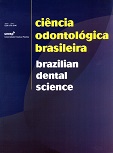Longitudinal study of removable partial dentures and hygiene habits
DOI:
https://doi.org/10.14295/bds.2007.v10i3.281Resumo
The removable partial dentures (RPD) are used to reestablish the phonetics, aesthetics and masticatory function for partially dentate patients, mainly those who compound the Brazilian poorest population, since RPD presents a relatively low cost. The rehabilitation gone to be successfully when besides the planning, the dentist orientate hygiene habits to the patient, and proserve the case. The present paper evaluates hygiene habits and RPD planning among a sample of RPD wearers, in a cross-sectional design. A questionnaire was applied and a clinical examination was performed by two previously calibrated examiners. The sample was composed by 83 patients, and 25 were males. It was verified that 49.4% of the patients brush their teeth three times per day and that 28.9% took approximately 4 minutes for each teeth brushing, 95.2% use other hygiene resources, besides toothbrushing, as dental cream (98.7%), dental floss (79.7%) and mouthrinses (55.7%). However 56.6% showed bacterial plaque and 21.7% presented caries at clinical exam. About the dentures, 74.7% was definitive RPD and 96.4% showed bilateral design. The requisites of stability, retention, occlusion and aesthetics was classified as good, in the majority of the cases; the hygiene was classified as good to regular. In 24% of the dentures, the base was deformed or fractured, 50.6% presented artificial teeth with detritions. Instead of patients’ adequate oral hygiene habits and satisfaction with RPD, more comprehensive explanations about oral care and more frequent follow-ups should be considered to improve plaque index and periodontal health among RPD wearers.Downloads
Downloads
Publicado
Como Citar
Edição
Seção
Licença
TRANSFERÊNCIA DE DIREITOS AUTORAIS E DECLARAÇÃO DE RESPONSABILIDADE
Toda a propriedade de direitos autorais do artigo "____________________________________________________________________" é transferido do autor(es) para a CIÊNCIA ODONTOLÓGICA BRASILEIRA, no caso do trabalho ser publicado. O artigo não foi publicado em outro lugar e não foi submetido simultaneamente para publicação em outra revista.
Vimos por meio deste, atestar que trabalho é original e não apresenta dados manipulados, fraude ou plágio. Fizemos contribuição científica significativa para o estudo e estamos cientes dos dados apresentados e de acordo com a versão final do artigo. Assumimos total responsabilidade pelos aspectos éticos do estudo.
Este texto deve ser impresso e assinado por todos os autores. A versão digitalizada deverá ser apresentada como arquivo suplementar durante o processo de submissão.




























